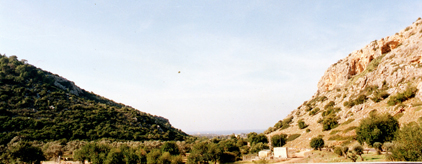Cyanobacteria have the ability to adapt to a number of environmental conditions and thus can be found in a variety of settings. Members of the cyanobacteria Nostoc family are nitrogen-fixers and key carbon sequestration contributors in agricultural environments. They can also produce hydrogen. The blue-green cyanobacterium Nostoc linckia grows on the rocky slopes of Lower Nahal Oren in Mount Carmel, Israel, where it is constantly exposed to environmental variations in temperature, solar radiation levels and moisture. During the summer months, the slopes of Lower Nahal Oren, nicknamed “Evolution Canyon,” receive significantly different amounts of solar radiation. The warmer south-facing side has a climate likened to an African savanna and receives 800 percent more solar radiation than the north-facing side, which has a milder climate compared to that of the Mediterranean region.
To better understand the effects of long-term natural environmental stress on bacterial genomes, samples of N. linckia from both the south-facing and north-facing slopes of Evolution Canyon will be sequenced. The draft genomes are expected to vary in size; the bacterial genome from the southern-facing slope, for example, is expected to be larger in order to cope with increased solar radiation stressor that does not affect the northern-facing cyanobacteria. Researchers also hope to better understand the metabolic pathways that allow microorganisms such as N. linckia to both play a role in the global carbon cycle as well as adapt to their environmental niches.

Photo: Michael Margulis
Principal Investigators: Volodymyr Dvornyk, University of Hong Kong
Program: CSP 2010